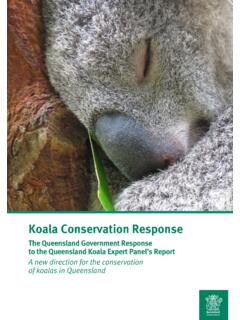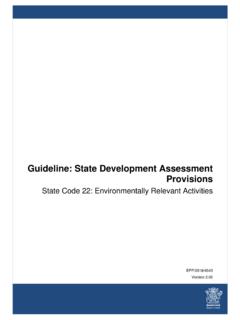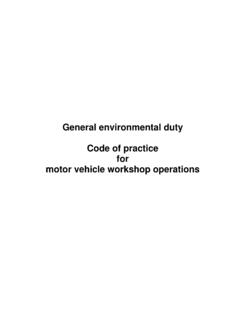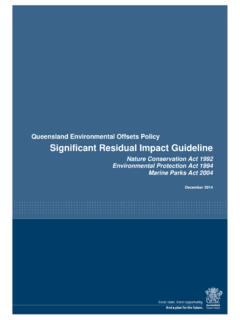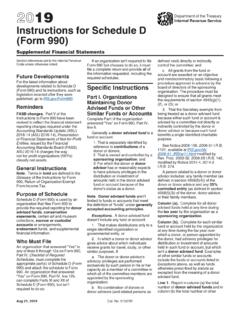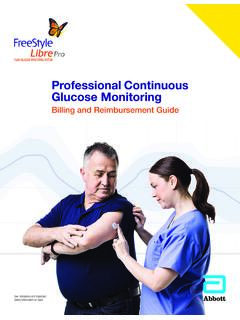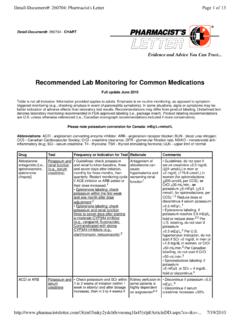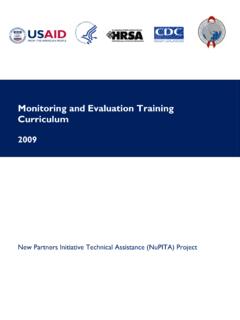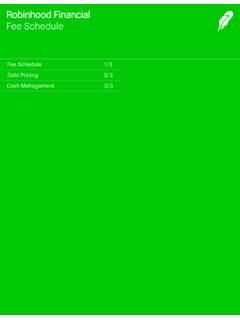Transcription of Monitoring and Sampling Manual - Environment
1 Monitoring and Sampling Manual Environmental Protection (Water) Policy 2009 Prepared by: Water Quality and Investigation, Department of Environment and Science (DES) State of Queensland, 2018. The Queensland Government supports and encourages the dissemination and exchange of its information. The copyright in this publication is licensed under a Creative Commons Attribution Australia (CC BY) licence. Under this licence you are free, without having to seek our permission, to use this publication in accordance with the licence terms. You must keep intact the copyright notice and attribute the State of Queensland as the source of the publication. For more information on this licence, visit Disclaimer If you need to access this document in a language other than English, please call the Translating and Interpreting Service (TIS National) on 131 450 and ask them to telephone Library Services on +61 7 3170 5470.
2 This publication can be made available in an alternative format ( large print or audiotape) on request for people with vision impairment; phone +61 7 3170 5470 or email Citation DES. 2018. Monitoring and Sampling Manual : Environmental Protection (Water) Policy. Brisbane: Department of Environment and Science Government. Acknowledgements The revision and update of this Manual was led by Dr Suzanne Vardy, with the valued assistance of Dr Phillipa Uwins, Leigh Anderson and Brenda Baddiley. Thanks are given to many experts who reviewed and contributed to the documents relating to their field of expertise. This includes government staff from within the Department of Environment and Science, Department of Agriculture and Fisheries, Department of Natural Resources, Mines and Energy and many from outside government.
3 Special thanks is given to staff from James Cook University, University of Queensland, Griffith University and the Great Barrier Reef Marine Park Authority, Hydrobiology Pty Ltd and Ecotox Services for their contribution to the Manual and/or expert review of documents. Particular thanks is also given to Paulina Kaniewska for facilitating the review and update of this Manual , to Sally Beecham for editing and formatting the Manual , to Reinier Mann and Michael Warne for their final edits, and to Munro Mortimer for his input to both the original Manual and this one. June 2018 iii Version history Refer to the individual sections of this document for the version history of each section. Version 1 February 2018 Version 2 June 2018 iv Contents Foreword.
4 1 Purpose .. 2 Section A: Sampling Design and Preparation .. 1 1. Sampling scope and design .. 2 Purpose and scope .. 2 Associated 2 Introduction .. 2 Importance of understanding the system being sampled .. 3 Why Sample? .. 4 Spatial boundaries of Sampling .. 5 What to sample .. 5 Where to sample .. 6 When to sample .. 6 How many samples should be collected? .. 7 Is grab Sampling adequate or should composite samples be taken? .. 7 Quality Control .. 7 Cost effectiveness .. 8 References and additional reading .. 8 2. Preparation for Sampling .. 9 Purpose and scope .. 9 Associated 9 Health and safety .. 9 Permits and approvals .. 9 Skills, training and experience.
5 9 Things to consider when preparing for field work .. 9 Preparation of a Sampling 9 Naming of sites and samples .. 10 The Sample Register .. 10 Communicating with the laboratory .. 10 Before Sampling .. 10 After Sampling .. 11 Anticipating potential court action .. 11 Sample containers, preservation, storage and holding times .. 11 Sample containers .. 11 Preservation, storage, and holding times .. 12 Transportation of samples .. 12 Packing samples .. 12 Samples requiring refrigeration .. 13 Samples requiring freezing immediately after collection .. 13 Chain of custody (COC) documents .. 13 v Security of samples .. 13 Sample seals or evidence bags.
6 13 Locked carrier boxes .. 14 Preparation of equipment .. 14 Essential items .. 14 References and additional reading .. 15 Appendix 1 .. 15 3. Record keeping, including taking field photographs and 16 Purpose and scope .. 16 Associated 16 Health and safety .. 16 Permits and approvals .. 16 Skills, training and experience .. 16 Equipment .. 16 Procedure .. 16 Prior to undertaking fieldwork .. 16 Undertaking 17 Upon return to the office .. 18 4. Quality control for water and sediment Sampling .. 19 Purpose and scope .. 19 Associated 19 Introduction .. 19 Quality control samples .. 19 Blanks .. 19 Other field quality control samples .. 20 Guidance on assessing quality control data.
7 21 Blanks .. 21 Duplicates .. 21 Certified reference material .. 21 Total versus 22 References and additional reading .. 22 5. Permits and approvals .. 23 Purpose and scope .. 23 Required permits and approvals .. 23 Granted permits or approvals .. 23 Permission to access land .. 23 6. Control and reference sites .. 24 Purpose and scope .. 24 Introduction .. 24 Consideration in selecting control and reference sites .. 24 Reference site criteria used for bioassessments .. 24 vi Reference site criteria used for physico-chemical water quality indicators .. 25 References and additional reading .. 26 Appendix 1 Reference condition selection criteria field sheet.
8 27 Appendix 2 Example of possible impacts for each selection criteria .. 30 7. Background information on the Global Positioning System and handheld units .. 33 Purpose and scope .. 33 Associated 33 Introduction .. 33 How GPS receivers calculate positions .. 35 GPS precision, accuracy and reliability .. 35 References and additional reading .. 36 8. Operating a basic handheld Global Positioning System unit for an investigation or compliance inspection .. 37 Purpose and scope .. 37 Associated 37 Health and safety .. 37 Permits and approvals .. 37 Skills, training and experience .. 37 Equipment .. 37 Procedure .. 37 Prior to undertaking fieldwork .. 37 Pre field trip check of GPS.
9 37 Pre field calibration of GPS .. 38 Reference points .. 39 Undertaking 40 Reference points .. 40 Recording coordinates .. 40 Post field calibration of GPS .. 40 Upon return to the office .. 40 Data handling .. 40 9. Choosing a laboratory and analytical method, holding times and preservation .. 41 Purpose and scope .. 41 Associated 41 Selection of laboratory .. 41 Selection of analytical methods .. 41 Limits of detection and reporting .. 42 Holding times and preservation .. 42 References and additional reading .. 42 Section B: Physical and Chemical Assessment .. 43 1. Background information on water quality measurements using in situ water quality instruments.
10 44 Purpose and scope .. 44 Associated 44 vii Introduction .. 44 Overview of measurements .. 44 Temperature .. 44 pH .. 45 Dissolved oxygen (DO) .. 45 Electrical conductivity (EC) .. 46 Salinity .. 46 Total dissolved solids .. 46 Turbidity .. 47 Transparency .. 47 References and additional reading .. 47 2. Water quality Sampling using in situ water quality instruments .. 48 Purpose and scope .. 48 Associated 48 Health and safety .. 48 Permits and approvals .. 48 Skills, training and experience .. 48 Field equipment .. 48 Procedure .. 49 Instrument maintenance and calibration .. 49 Records .. 49 Calibration .. 49 Taking a reading with a multi-parameter water quality meter.
